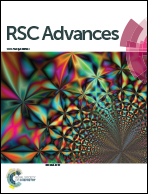A gold microarray electrode on a poly(methylmethacrylate) substrate to improve the performance of microbial fuel cells by modifying biofilm formation†
Abstract
Previous studies have shown that poly(methylmethacrylate) (PMMA) performed better than other polymers and glass in the cell proliferation experiments. However, little attention has been paid to this advantage of PMMA in the study of microbial fuel cells (MFCs). Herein, a gold line microarray electrode deposited on a biocompatible PMMA substrate was designed as an anode to investigate the bacterial attachment and compare with the same gold line microarray electrode on glass and a rectangular plat gold electrode of same surface area. After Shewanella oneidensis MR-1 was injected under anaerobic culture conditions, MFCs using three types of electrodes accomplished similar stable highest current density (approximately 1400 mA m−2), based on their same surface area of gold. However, the one on PMMA showed a superior property in the start-up time, which only needs several minutes. With the continuous operation in eight cycles by periods of time, it always kept the advantage of short start-up time, having a better performance than that of the other two types of electrodes. This means that PMMA was a kind of suitable material for S. oneidensis MR-1 to form an effective biofilm and improve the performance of MFCs. It could be preliminarily explained by the extended Derjaguin–Landau–Verwey–Overbeek (DLVO) theory.


 Please wait while we load your content...
Please wait while we load your content...